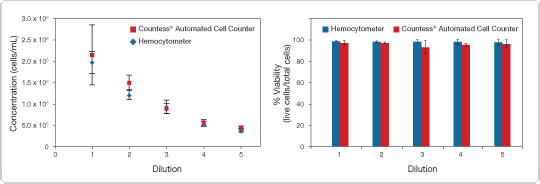Search
The Next Generation in Cell Counting
The Countess® Automated Cell Counter is a benchtop instrument that uses digital image capture and sophisticated image analysis software to determine the cell count, cell size, and percent viability of a cell population, typically in just 30 seconds. Results are accurate and consistent, and the procedure has been validated with a wide range of cell lines. Stem cells present a particular challenge for cell counting because they often exhibit variable morphology, especially when grown on feeder layers, and can be associated with cell debris in the culture medium. The analysis parameters of the Countess® instrument can be adjusted to compensate for these characteristics, so that stem cells can be easily and accurately counted.
Optimizing Countess® Instrument Settings for Stem Cell Counting
The Countess® Automated Cell Counter is equipped with programmable settings that allow the user to adjust analysis parameters—sensitivity, maximum and minimum cell size, and circularity—in order to tailor a protocol for a specific cell type. Post-count data manipulation can be performed on the instrument, or using the Countess® software with archived data. To measure the same cells with different sensitivity and circularity settings, separate readings must be taken. In contrast, the size gate can be set before or after cell counting.
To determine the optimal settings for counting stem cells using the Countess® Automated Cell Counter, human embryonic stem cells (hESCs) were cultured using a variety of methods: using a feeder cell layer in a culture dish; using Geltrex™ matrix–coated culture dishes; and using StemPro® hESC SFM feeder-free medium. The cells were then counted on the Countess® Automated Cell Counter and compared to the counts obtained on a hemocytometer. GIBCO® rat fetal neural and mouse embryonic stem cells, as well as StemPro® human adipose-derived stem cells, were also counted using both techniques. We found that all of these stem cell lines cultured using feeder-free methods did not require further parameter setting modifications from default settings to obtain accurate cell concentrations (data not shown) from single-cell suspensions; however, the hESC cells cultured using a feeder cell layer needed some adjustments to the analysis parameters for more accurate cell counting.
Adjusting Parameters for Stem Cells Grown on a Feeder Layer
Stem cells grown in some conditions, such as on feeder layers, can exhibit variable morphology, including lighter, less-defined edges; this may make it difficult for the cell counter to distinguish which cells to include in the count (Figure 1A). To alleviate this issue, you can simply increase the sensitivity setting, allowing the instrument to include these cells in the count (Figure 1B). With an increased sensitivity setting, however, the instrument is also more likely to count debris that was previously ignored. Because stem cell debris is often smaller than the size of the cells to be counted, increasing the minimum cell size parameter will counter this problem by excluding the debris from the count (Figure 1C).
Our suggested settings for stem cells grown on a feeder layer are shown in Table 1. Using these settings, we were able to successfully count and determine the viability of hESCs grown on fibroblasts with a high degree of accuracy, and over a broad range of cell concentrations (Figure 2).

Figure 1. Adjusting Countess® instrument parameter settings for stem cells grown on a feeder layer. hESCs grown on a mouse fibroblast feeder layer were dissociated into a single-cell suspension using TrypLE™ Express dissociation enzyme and counted using the default settings on the Countess® Automated Cell Counter. Blue circles outline cells that are counted as viable; red circles outline cells that are counted as dead; and black circles indicate objects that are excluded from the count due to the size settings. (A) Some of the less-developed and less-defined cells are not included in the count, as indicated by the cells that are not marked with a blue, red, or black circle. (B) A different slide of the same single-cell suspension was counted after increasing the sensitivity setting from 5 to 8, resulting in fewer cells excluded. (C) The image in (B) was recounted, leaving the sensitivity setting at 8 while increasing the minimum cell size from 5 to 8. As shown, smaller feeder cells and debris were excluded from the count.
| Parameter | Default Settings | Suggested Stem Cell Settings |
|---|---|---|
| Sensitivity |
5
|
8
|
| Minimum cell size |
5
|
8
|
| Maximum cell size |
60
|
60
|
| Circularity |
80
|
80
|

Figure 2. High accuracy of hESC cell counts (Left panel) and viability (Right panel). hESCs were concentrated, serially diluted 3:1, and counted using the Countess® Automated Cell Counter and the C-Chip disposable hemocytometer (Digital Bio). Data points represent 3 independent measurements on the Countess® instrument or hemocytometer. Viability was determined by trypan blue exclusion.
Accuracy You Can Rely On
Automated cell counting bypasses tedious manual operations and calculations required with the standard hemocytometer, while offering generally greater accuracy and precision. The Countess® Automated Cell Counter also makes it practical to count multiple replicates and to design experiments with large numbers of samples for counting, even with stem cells. Learn more about the Countess® Automated Cell Counter and its applications in stem cell research.
For Research Use Only. Not for use in diagnostic procedures.
See a complete listing of the products discussed in this article.
View products
Find more information on cell counting and viability measurements of stem cell populations.
- Learn More about the Countess® Automated Cell Counter
- Learn More about Products for Stem Cell Research
> Get a copy of this article as it appears in the print version of BioProbes 63.
